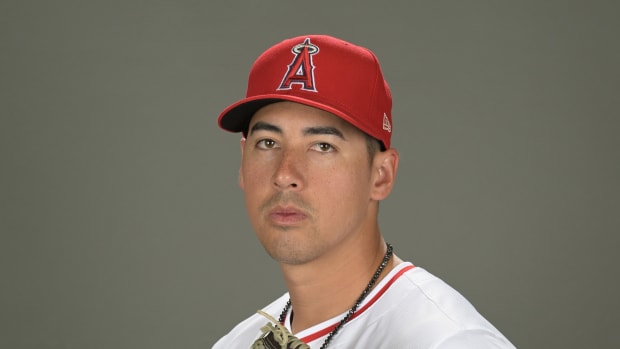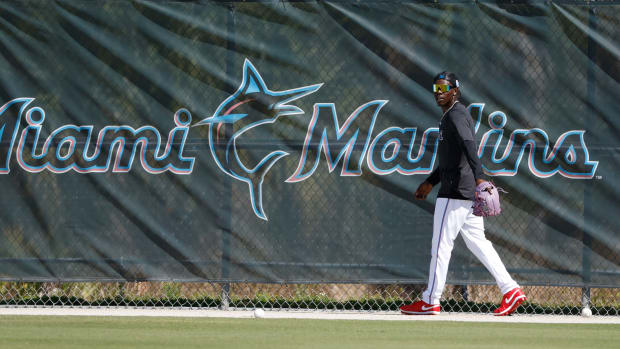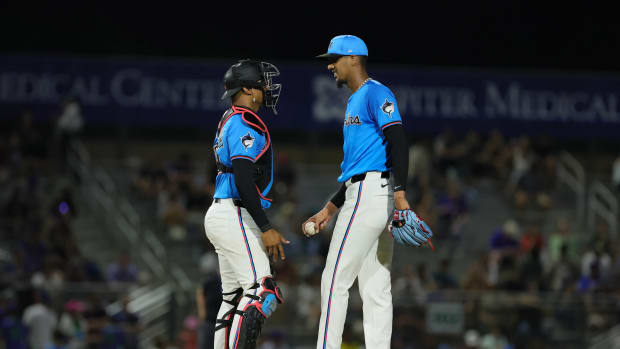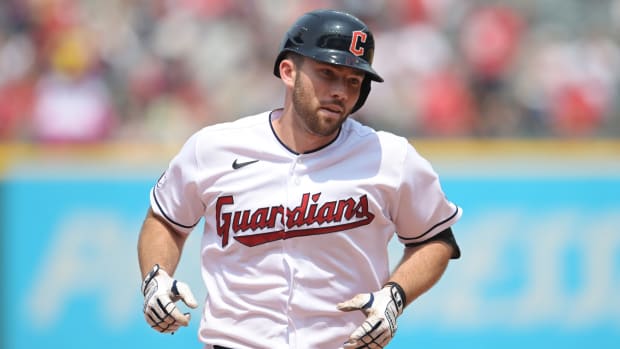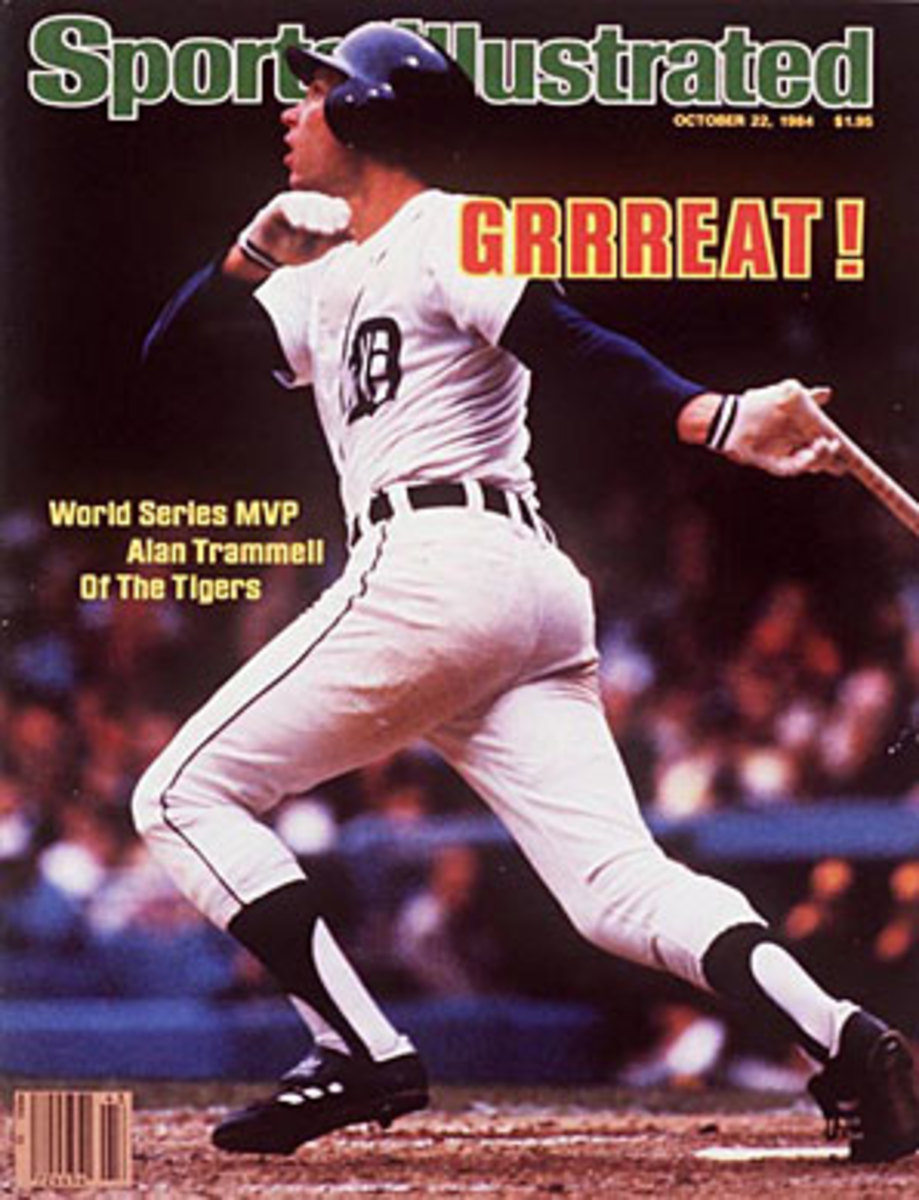
JAWS and the 2014 Hall of Fame ballot: Alan Trammell
Alan Trammell led the Tigers to the title in 1984. (John Iacono/SI)
The following article is part of my ongoing look at the candidates on the BBWAA 2014 Hall of Fame ballot. Originally written for the 2013 election, it has been updated to reflect last year's voting results as well as additional research and changes in WAR. For a detailed introduction to JAWS, please see here. For the schedule and an explanation of how posts on holdover candidates will be presented, see here.
Once upon a time, shortstops didn't hit. In the 1970s, when Alex Rodriguez, Derek Jeter and Nomar Garciaparra were still wearing short pants, the idea that a slick-fielding defensive wizard could be a total zero with the bat and still help his team reached its zenith, which is to say that shortstops' collective offensive production reached its nadir. In 1977, when major league teams averaged 4.47 runs per game on .264/.329/.401 hitting, shortstops hit a collectively appalling .248/.299/.330. The player most closely embodying that line that year was the Padres' Bill Almon, a former No. 1 overall draft pick who hit .261/.303./336 with two homers, 20 steals and 20 sacrifice hits — a line as ugly as his brown-and-yellow uniform.
In the early 1980s, things started to change, as the American League produced a trio of talented two-way shortstops who could field their position and pose a substantial threat to pitchers. The Brewers' Robin Yount, who debuted in the majors in 1974 at the tender age of 18, evolved into a top-notch hitter and earned MVP honors in 1982 as Milwaukee won the pennant. The Orioles' Cal Ripken kicked off a stretch of 10 straight seasons with at least 20 homers in his official rookie season of 1982 — as well as a record-setting consecutive games streak — and the next year, he too claimed an MVP award as Baltimore won the World Series.
Debuting between those two, in late 1977, was the Tigers' Alan Trammell. He didn't win the MVP award in 1984 — that honor went to reliever Willie Hernandez, a teammate — but he hit .314/.382/.468 while helping Detroit to a world championship. Trammell would spend 20 years with the Tigers, and while he didn't reach 3,000 hits like Yount (who eventually moved to centerfield and won another MVP award) or Ripken (who also won a second MVP before moving to third base for his final few years), he did make six All-Star teams and win four Gold Gloves in his career, even while competing for attention with the other two.
Despite his Hall of Fame-caliber numbers, the BBWAA voters have given Trammell little recognition in his first 12 years on the ballot. He didn't reach 20 percent of the vote until his ninth time around, in 2010 and didn't reach 30 percent until 2012, when he peaked at 36.8 percent. He fell back to 33.6 percent on the most recent ballot, and it now appears that if he's ever going to get his due, it will be from some form of the Veterans Committee instead of the BBWAA.
Player | Career | Peak | JAWS | H | HR | SB | AVG/OBP/SLG | OPS+ |
Alan Trammell | 70.4 | 44.6 | 57.5 | 2365 | 185 | 236 | .285/.352/.415 | 110 |
Avg HOF SS | 66.7 | 42.8 | 54.7 |
A native of San Diego, Trammell was drafted straight out of high school by the Tigers as the second pick of the second round in 1976. Though their first-round pick, pitcher Pat Underwood, wouldn't amount to much in the majors, it was still a banner draft for Detroit, which landed pitchers Dan Petry and Jack Morris in the fourth and fifth rounds, respectively. Who knows what might have happened had they been able to sign seventh-round pick Ozzie Smith, a shortstop who elected to return to school and was chosen the next year by the Padres (he replaced Almon, but wasn't much of a hitter himself).
Despite Trammell's youth, the Tigers advanced him quickly; after 41 games in the Rookie-level Appalachian League in '76, he jumped straight to Double A Montgomery of the Southern League and spent the following season there before being recalled by the Tigers in September, still just 19 years old. On Sept. 9, 1977, he and second baseman Lou Whitaker, a 1975 fifth-round pick who was his double-play partner in Montgomery, both made their major league debuts; they would remain partners in the middle infield through 1995. They joined catcher Lance Parrish, a first-round 1974 pick who had debuted on Sept. 5, and Morris, who had debuted in July, to form a homegrown quartet that would anchor the team for nearly a decade.
Trammell hit .268/.335/.339 with three homers and three steals en route to a 2.8 WAR season in 1978. He tied for fourth in the Rookie of the Year balloting, with Whitaker taking home the award. In 1980 — Detroit's first full season under manager Sparky Anderson — Trammell had his first big campaign, earning All-Star and Gold Glove honors by hitting .300/.376/.404 with nine homers, good for 4.8 WAR. Not bad for a 22-year-old.
Trammell added a Gold Glove the following year, but it wasn't until his age-25 season in 1983 that he advanced further with the bat. That year, he hit .319/.385/.471 with 14 homers and 30 steals, both career highs to that point; his 6.0 WAR ranked eighth among position players.
In 1984, he had a a virtual carbon copy season with the bat, and a 16-run improvement on defense (according to Total Zone) helped him accumulate 6.6 WAR (fourth in the league). More importantly, the Tigers jumped out to a 35-5 start, finished 104-58 and won the World Series for the first time since 1968. Trammell won Series MVP honors, going 9-for-20 in the five-game triumph over his hometown Padres, swatting a pair of homers in a Game 4 win in which he drove in all four runs.
After a down 1985, Trammell rebounded with a 21-homer, 6.3 WAR season — good for fifth in the AL — in 1986. In 1987 he had a monster year for a Detroit team that was the class of the league, winning 98 games and the AL East flag. Even in a lineup with heavy hitters Darrell Evans, Kirk Gibson, Chet Lemon and Matt Nokes, Trammell stood out via a .343/.402/.551 showing with a career-best 28 homers, not to mention 21 steals in 23 attempts. His 8.2 WAR was a career high and ranked second in the AL behind Wade Boggs' 8.3. Alas, the Tigers lost the ALCS to an 85-win Twins team that had actually been outscored by their opponents by 20 runs, and Trammell lost a very close AL MVP vote to George Bell, who hit 47 homers and drove in 134 runs for Toronto but compiled just 5.0 WAR. He was robbed!
Trammell's offense had its ups and downs over the next several years — big seasons in 1988, 1990 and 1993, interspersed with mediocre ones — and he became more injury-prone, with trips to the disabled list preventing him from surpassing 128 games in all but one season for the rest of his career, which ended in 1996. Even so, strong defense buffeted his value; excluding the 1992 season, when he was limited to just 29 games due to a broken right ankle, he averaged 4.8 WAR and 122 games a year over the 1988-93 span.
The Tigers couldn't get back to the playoffs for the rest of his time in Detroit, plunging from 88 wins in 1988 to 59 in '89 and posting just one more winning season through the remainder of Trammell's career. In 1993, he hit .329/.388/.496, albeit in just 112 games; that year, he made 27 starts at third base and eight more in the outfield, largely to make room for Travis Fryman, a slugging third baseman who had been able to hold down the shortstop position in Trammell's increasingly frequent absences. After three more seasons of part-time duty, Trammell retired at age 38.
On the traditional merits, Trammell looks like a solid Hall of Fame candidate, with 2,365 hits and 185 homers, numbers that aren't Ripken- or Yount-like but are still substantial when accompanied by his All-Star appearances and Gold Gloves, if not that missing MVP award. He scores 118 on Bill James' Hall of Fame Monitor metric, which measures how likely (not how deserving) a player is to be elected by awarding points for various awards, league leads, postseason performance and so on, with 100 representing "a good possibility" and 130 a virtual cinch.
Relative to the other Hall of Fame shortstops, Trammell surpasses the career and peak WAR standards at the position with room to spare, and winds up 2.8 points above the JAWS standard, good for 11th on the all-time list. Of the 10 players above him, all are in the Hall except the still-active Alex Rodriguez and the Deadball era's Bill Dahlen; Ripken, Yount and Smith are among those in Cooperstown, which does suggest that Trammell was the fourth-best shortstop of that bunch, though not by a huge amount; his peak score is actually higher than those of Smith and 2012 inductee Barry Larkin, whose career ran from 1986 through 2004:
Rk | Player | Career | Peak | JAWS | H | HR | AVG/OBP/SLG | OPS+ | TZ |
3 | Cal Ripken | 95.6 | 56.1 | 75.8 | 3184 | 431 | .276/.340/.447 | 112 | 181 |
6 | Robin Yount | 77.1 | 47.3 | 62.2 | 3142 | 251 | .285/.342/.430 | 115 | -47 |
7 | Ozzie Smith | 76.5 | 42.3 | 59.4 | 2460 | 28 | .262/.337/.328 | 87 | 239 |
11 | Alan Trammell | 67.1 | 43.3 | 55.2 | 2365 | 185 | .285/.352/.415 | 110 | 77 |
13 | Barry Larkin | 70.2 | 43.1 | 56.6 | 2340 | 198 | .295/.371/.444 | 116 | 18 |
Avg HOF SS | 77.3 | 46.4 | 61.8 |
Trammell lags ever so slightly behind all but Smith as a hitter, but he was the third-best fielder of the bunch according to Total Zone (I've included time at other positions in this as well, since they all wind up as part of each player's overall value). In short, there doesn't seem to be anything to suggest that he doesn't belong in the Hall if those four contemporaries are in.
The patchiness of Trammell's late career probably hasn't helped his candidacy. The same is likely true of his disastrous stint managing the Tigers from 2003-05, including their 43-119 season in his first year and sub .500 records in all three seasons. He debuted on the 2002 ballot at 15.7 percent and slipped even lower the next two years. For a while it seemed he might be subject to Whitaker's undeserved fate of falling entirely off the ballot. He has hung on, however, finally breaking 20 percent in 2010 (22.4 percent) and gaining 12 percentage points in 2012 to surge to 36.8 percent before falling back to 33.6 percent in 2013.
With a voting share that low, it would be unprecedented in the annals of modern BBWAA voting (since 1966, when it returned to an annual basis) to rally to 75 percent over the next three cycles. That said, four other players with even lower shares in their 12th year (Nellie Fox at 30.6 percent, Ron Santo at 30.2 percent, Richie Ashburn at 30.1 percent and Bill Mazeroski at 30.0 percent) eventually gained entry via the Veterans Committee. The same can be said for Red Schoendienst, who was more or less even with Trammell in years 10 and 11 before climbing to 42.6 percent in year 12.































